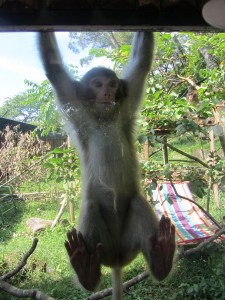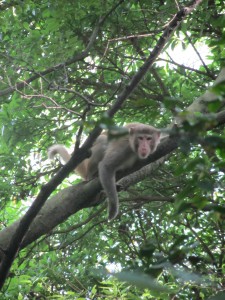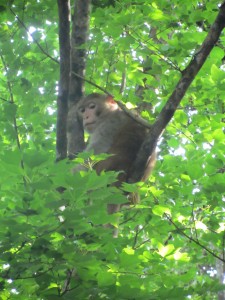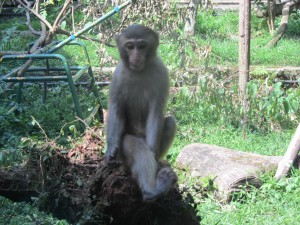 Our group, Krista and Ryanne, worked in the live educational display (LED) section this week at Kadoorie Farm and Botanic gardens. This means that we worked with a zoo keeper helping her with her daily tasks. Of all the animals we encountered during the day our favourite was the Macaques. This is a type of monkey that lives in the area and like many primates they are very social creatures. In the wild, they live in troops.
Our group, Krista and Ryanne, worked in the live educational display (LED) section this week at Kadoorie Farm and Botanic gardens. This means that we worked with a zoo keeper helping her with her daily tasks. Of all the animals we encountered during the day our favourite was the Macaques. This is a type of monkey that lives in the area and like many primates they are very social creatures. In the wild, they live in troops.
At Kadoorie, there are 7 Macaques: Rambo, Rosie, Darlexi, Sita, Oliver, Woowoo, and Quasi. These monkeys are of varying age and have found themselves to be at Kadoorie for a variety of reasons. For some of the younger monkeys, like Sita and Oliver, their mother was no longer capable of caring for them. For many of the other monkeys the government picked had them up as they were causing a public disturbance. For example, Woowoo was caught many times causing a ruckus at the hospital finding food by scavenging through the garbage.
In Hong Kong there is the urban area and then there is nature; there is not much of an in-between state. With Macaques there is great competition for food, especially in the winter. Any monkey that becomes ostracized struggles to survive. These are the conditions when they most often begin to stumble upon human garbage and find that this is able to satisfy their hunger. Eventually, they make the connection that humans equal food; which in turn results in the harassment of humans by the monkeys. And make no mistake cute turns to kind of scary pretty quickly: these monkeys can be quite aggressive so they become a nuisance to humans.
 The human-animal relationship is a complex one. In this scenario, despite being so closely related to humans, the monkeys are often not seen as being sentient and intelligent like us. Instead, once they come into conflict with humans, they are more clearly positioned on the animal side of that boundary. Yet people often lay the foundation for this conflict by encouraging the monkeys by feeding them. And when relations break down the government gets called to deal with the “problem”. The immediate solution to the problem can result in captivity and sometimes euthanasia, an outcome that is less than ideal for anyone and one that doesn’t tackle the root of the problem.
The human-animal relationship is a complex one. In this scenario, despite being so closely related to humans, the monkeys are often not seen as being sentient and intelligent like us. Instead, once they come into conflict with humans, they are more clearly positioned on the animal side of that boundary. Yet people often lay the foundation for this conflict by encouraging the monkeys by feeding them. And when relations break down the government gets called to deal with the “problem”. The immediate solution to the problem can result in captivity and sometimes euthanasia, an outcome that is less than ideal for anyone and one that doesn’t tackle the root of the problem.
Once in captivity, it becomes very hard to provide these creatures with the stimulation they need. At Kadoorie there is a divide between the monkeys. The older monkeys (Rosie, Rambo and Darlexi), do not get along with the younger monkeys (Sita, Quasi, Woowoo and Oliver). Despite the best efforts of Kadoorie staff only half of them get to go outside for the day (though the mini-troops are rotated regularly). Captivity cannot provide the kind of space, nor relationships that simulate the wild and the artificial structuring of troops is often not all that successful.
 In addition to the monkeys’ not getting along, the way they came to be here in the first place plays a role in their future ability to be accepted by members of their own species. For example, Sita was hand raised by people as she came to Kadoorie at only two weeks old. Understandably, she prefers the company of humans rather than her fellow Macaques and one unintended consequence of saving her life is that she has to manage being bullied by the other monkeys. This is a perpetual dilemma that is constantly being negotiated in rescue work with animals.
In addition to the monkeys’ not getting along, the way they came to be here in the first place plays a role in their future ability to be accepted by members of their own species. For example, Sita was hand raised by people as she came to Kadoorie at only two weeks old. Understandably, she prefers the company of humans rather than her fellow Macaques and one unintended consequence of saving her life is that she has to manage being bullied by the other monkeys. This is a perpetual dilemma that is constantly being negotiated in rescue work with animals.
An interesting question that arose for us concerned the question of animal identity. When you take away an instinctual part of an animal`s life (such as living with and choosing their own troop), do you take away the identity of these animals? In other words, is Sita only part Macaques? It is easy to see that she has a need for humans yet for her own sake she lives with monkeys. But it’s an uneasy ‘living’. Sita doesn’t fully understand group dynamics nor does she altogether seem to enjoy interactions with her own kind. She would be shunned in the wild and she is being shunned in captivity. It is a wicked problem – a dilemma that arises in part because we are damned if we do – i.e. if we save them, and we are damned if we don’t. Whatever we do, it won’t be the wild, but will it be wild enough? Most of the time, if Kadoorie is an example of what we can do, the answer is yes, it is enough – but only with an enormous amount of commitment, care and resources.
Ryanne and Krista

